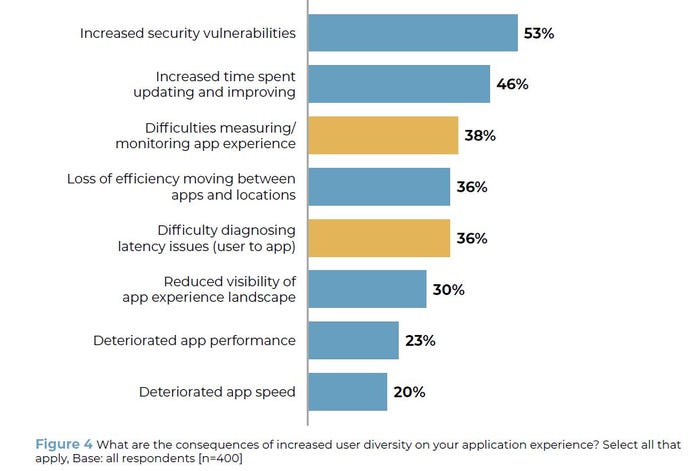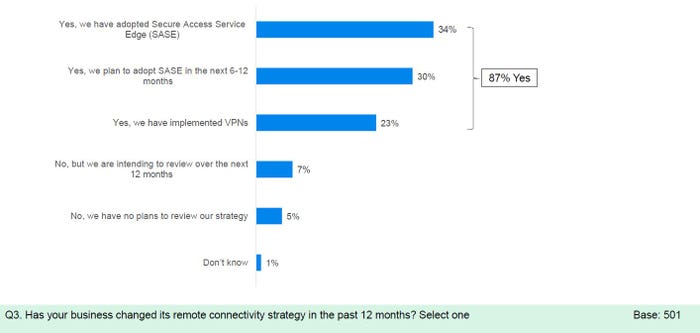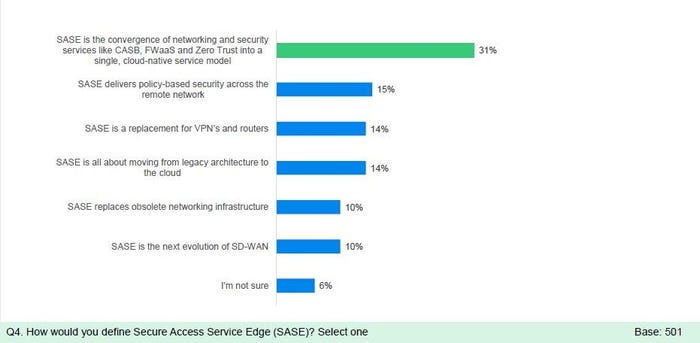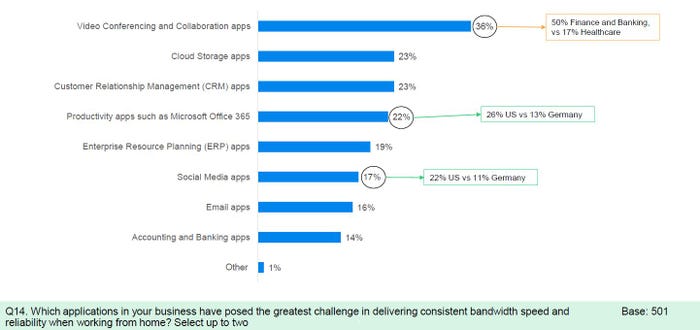SASE Roundup: Versa, Prosimo Share Studies on Application Performance, Multi-CloudSASE Roundup: Versa, Prosimo Share Studies on Application Performance, Multi-Cloud
Distributed workforces desperately need to ensure application performance, security and observability.

Businesses face serious application performance and security hurdles in the post-pandemic world.
Versa Networks and Prosimo have unveiled surveys that touch on businesses’ struggles connecting distributed workforces. The companies both commissioned Sapio Research to survey IT decision makers. Versa’s study asked respondents about their company’s secure access service edge (SASE) adoption. Prosimo’s asked respondents about application experience and multicloud transit while utilizing data from its own points of presence (PoPs).
Remote Workforces Stick
Versa’s study found that companies on average will keep 44% of their workforce at home permanently or on a semi-regular basis even after restrictions lift. Prosimo found that the shift to remote has helped increase the diversity of both users and applications. Device diversity has increased by 79%, and location diversity has gone up by 77%

Source: Prosimo State of Enterprise Multi-Cloud Infrastructure
Moreover, enterprises have by and large moved to the cloud. Versa’s study found that 84% of businesses have accelerated their cloud adoption and digital transformation plans.
We recently compiled a list of 20 top SD-WAN providers offering products and services via channel partners. |
Increased distribution has led to a key underlying concern: security. For Promiso’s respondents, growing user diversity has led to an increase in security vulnerabilities, which dwarfs worries about performance and speed. Similarly, 76% of Versa respondents said security risks are higher when employees are working from home.

Source: Prosimo State of Enterprise Multi-Cloud Infrastructure
SASE
Many companies are working to adopt a secure access service edge (SASE) posture in the next year, according to Versa’s report. Nearly two in three (64%) respondents say they have already adopted SASE or will in the next year.

Source: Versa Networks and Sapio Research, “Experiences and Attitudes Towards a Post-COVID Workforce”
However, the study pointed out a disconnect. Only 31% of respondents knew how to define SASE. While mostly every respondent touched on a component of SASE (such as the movement away from legacy architecture to the cloud), plenty of people missed Versa’s definition: “the convergence of networking and security services like CASB, FWaaS and zero trust into a single, cloud-native service model.” SASE is more than just SD-WAN 2.0.

Source: Versa Networks and Sapio Research, “Experiences and Attitudes Towards a Post-COVID Workforce”
SASE and IT
In addition, the IT team – not the security team, network team or C-suite – typically bears responsibility for SASE adoption. The IT shouldered the burden 61% of the time, although this number was significantly higher in the U.S. Fascinatingly, 28% of French companies relied on their board or C-suite to procure SASE infrastructure.
Versa chief marketing officer Michael Wood said IT and security teams have faced a major burden in the last year and will continue to face pressure.
“While the survey shows that there is still some work to do in educating IT and security professionals about the true meaning of SASE, the imperative to address both remote security and connectivity issues has led companies away from the old VPN technologies that were riddled with security holes toward SASE, which gives them …
… a compass for the future. While SASE has served them well during lockdown, it will also prove a major asset as they contemplate the move back to the office and toward hybrid working,” Wood said.
What does a post-COVID workforce look like? In a recent survey, over 500 security and IT decision-makers shared their attitudes towards digital transformation, #WFH, and the shift to the cloud. Download the free e-book to read the interesting findings: https://t.co/PcM25QJ2re pic.twitter.com/DyE0w2jNbI
— Versa Networks (@versanetworks) June 16, 2021
Performance
In addition to worrying about security, businesses worry about performance. The Versa study identified video conferencing and collaboration apps as by far the most troublesome when it comes to performance and reliability. More than one in three (36%) respondents identified video and collaboration as a problem area. Financial services particularly struggled with video conferencing and collaboration apps.

Source: Sapio Research and Versa Networks, “Experiences and Attitudes Towards a Post-COVID Workforce

Prosimo’s Mehul Patel
Prosimo head of marketing Mehul Patel gave the example of virtual desktop infrastructure (VDI) apps, whose optimization process requires 15 different components.
“You need to understand the context of the type of application to really make sure you’re applying the right optimization techniques and even the right transit connectivity,” Patel said.
Multicloud
Prosimo’s report argued that businesses will find improved user-to-application performance if they utilize multicloud transit. Prosimo reported a 55% per route improvement in network transit latency when users took a multicloud route, compared to direct methods. Multicloud even bested the use of single-cloud transit by 45%.
That high performance comes with a drawback: complexity. To that point, Partners will need to help customers with security as well as observability.
“The value is definitely in using multicloud to deliver a better application experience. But just be cautious that when you get there, there are some cobwebs that will be uncovered as you go down that channel,” Patel said. “The benefits outweigh the complexity, but it is complex.”
Patel said customers struggling with a lack of expertise, particularly in cloud connectivity; therefore, a partner who can offer expertise in AWS, Azure or Google Cloud Platform can provide the godsend they need.
“As a partner, the value of you saying, ‘Hey, we have AWS expertise in networking,’ or ‘We have Azure expertise in X,’ is going to be something that enterprises want,” Patel said.
📣📣 We’re proud to introduce the 2021 “State of Multi-Cloud Infrastructure” report. We uncover challenges & opportunities faced by enterprises on their #multicloud journeys and arm you with the info to transform application experience. Download the study: https://t.co/gHdNlnEvRT pic.twitter.com/r6DaL9XMpJ
— Prosimo.IO (@Prosimo_io) June 16, 2021
About the Author
You May Also Like


